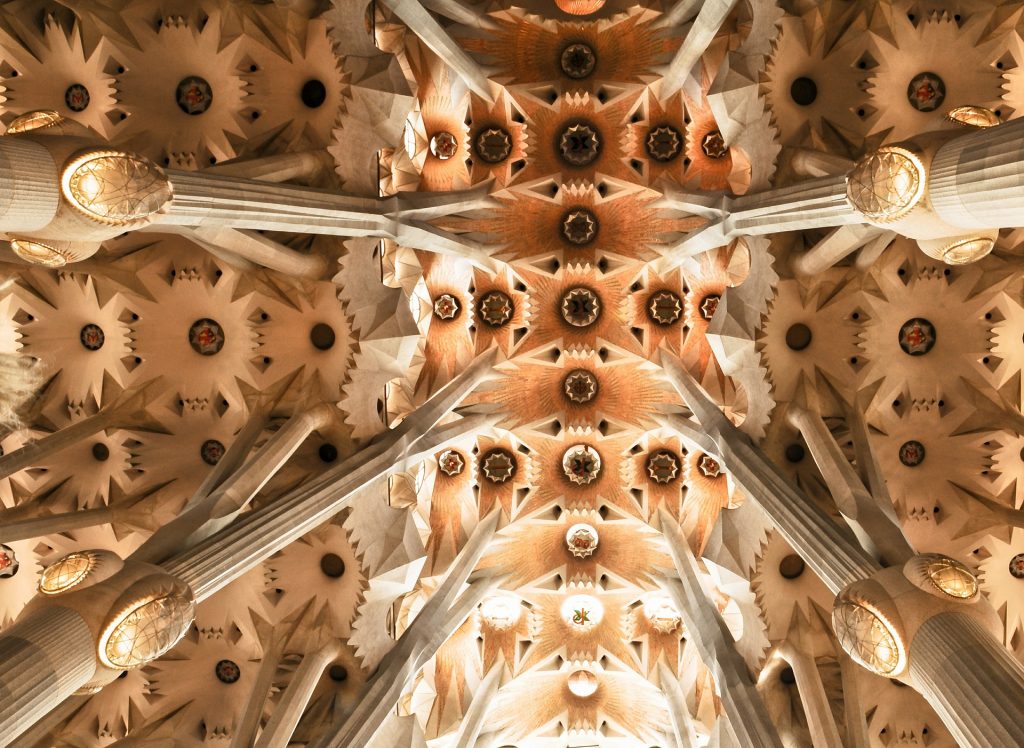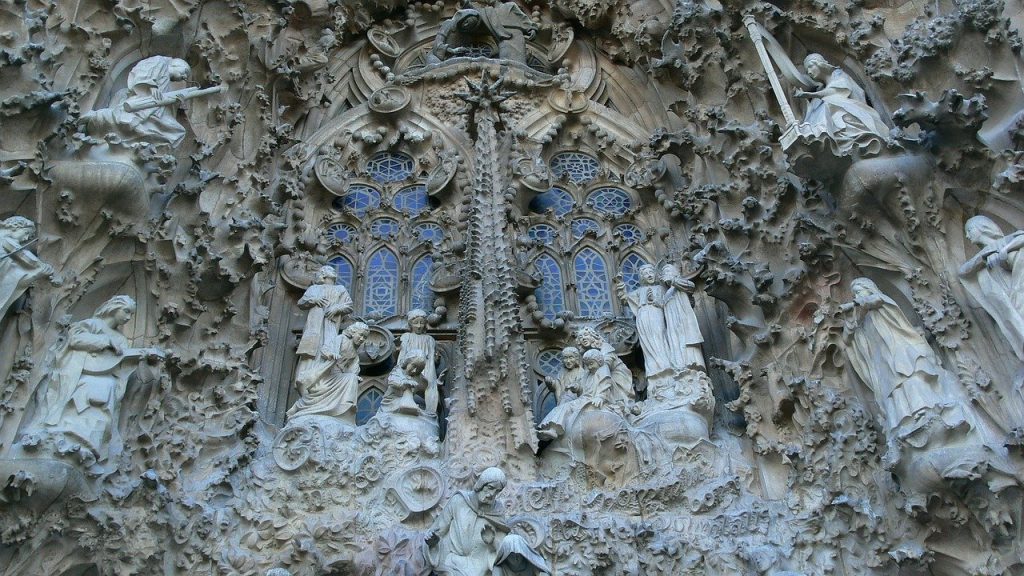Located in the middle of Barcelona, Sagrada Familia is a masterpiece from the brilliant mind of Antoni Gaudi. The temple is a Roman Catholic church with a rich history of over 100 years.
Although the church has an ever-present crowd, it also functions as a place of worship. Pope Benedict XVI consecrated the church in 2010, and the Chapel of the Blessed Sacrament and Penance of the Sagrada Familia is reserved for prayer. Whether you visit the church as part of an architectural tour or as a pilgrimage, it leaves all its visitors in various states of awe. With a slow and steady march towards completion, it's hardly a surprise that there are many unknown facts about this work of art and architecture.
1. Construction time: What year will Sagrada Familia be completed?
The construction of the church has taken more time than we can imagine. Antoni Gaudi joined the project when he was thirty years old, and from 1914 he focused exclusively on the church. At the death of Antoni Gaudi, in 1926, not even a quarter of the work was completed. It wasn't until 2010 that the church passed the midpoint.
The expected year of completion is 2026, marking the 100th anniversary of Gaudí's death. (However, it is thought to take until 2030 to add decorative details.) When completed in 2026, the Sagrada Familia will take 10 times longer to build than the Great Pyramids, 123 years longer than the Taj Mahal, 50 years more than the Great Wall of China.
2. It all starts with a bookseller...and another architect
Josep Maria Bocabella, on his visit to the Vatican, wanted a church to be built in Spain, similar to those he had seen in Italy. Funded by private donations, construction began in 1882 under the architect Francisco Paula del Villar. Had it continued with him, the Sagrada Familia would have been a standard Gothic Revival church. However, he resigned a year later and Antoni Gaudí took over. With only the apse, Gaudi radically changed the plans and today's Sagrada Familia was born.

3. Clean and geometric
Gaudí's design for the church was made with the foresight that any architect who came after him could understand the drawings and details and continue construction. He also made models of the facade for future architects to base their designs on his vision. Also, because he knew that the church would not be completed in his lifetime, he planned the construction in stages. This was done so that architects from different periods could add their own style to the design of the church.
4. Facades and symbolism
Of the three main facades, the east (actually northeast) facade, also known as the Nativity facade, is the only one that was built under Gaudí's watchful eye. The Passion Facade (simplified West) is built and open to visitors, while the Glory Facade (simplified South) is still under construction.
The Nativity Facade, which celebrates the birth of Christ, has three portals – Hope, Mercy and Faith. The faces of the Portal of Mercy were made using the death masks of the deceased people of Barcelona and forms of the faces of the workers. This is Gaudí's way of making the church a part of the people.
The Passion Facade is dedicated to the death of Christ and is designed to be clear and simple. This facade has fewer sculptures compared to the Nativity facade. Scenes from the Last Supper, the kiss of Judas, the crucifixion and the resurrection are depicted. There are 6 large and leaning columns that look like the trunks of giant sequoias. Above this are 18 smaller and white columns representing bones.

5. 12 multi-peaked towers
Each facade consists of 4 towers (12 towers in total) representing the apostles of Jesus Christ. Then next to these towers, near the middle of the church, there are 6 higher towers, 4 of which are dedicated to the Evangelists. These 4 are the same height and designed similarly. These 4 towers surround a tall tower in the center representing Jesus. This tower will bring the height of the structure to a total of 560 feet and make it the tallest church in Europe.
The sixth tower is in the very north and is shorter than those representing the evangelists. However, she is stronger and represents the Virgin Mary. The tower of Jesus will be covered with a cross, while the other towers will have different symbols. The towers of the 3 main facades will have episcopal symbols.
Besides the 18 towers, the church has other smaller peaks. On them are other religious symbols, such as sheaves of wheat, grapes, etc., representing the Eucharist.
6. Nature and God's work
Gaudí is known for drawing inspiration from Nature, and his buildings repeatedly nod to nature's bounty. One of the first things Gaudí did after taking over the design of the Sagrada Familia was to get rid of any straight lines and angles, as they did not look natural. The interior of the Sagrada Familia was designed to represent Nature, with columns like trees and various creatures hidden throughout the basilica.
He also believed that the work of men should not outweigh the work of God, and designed the central tower to be a meter shorter than the Montjuic hill in Barcelona.
7. Magic square on the facade of passion
Like out of a Dan Brown book, Passion's facade has a magic 4×4 square that baffles everyone. Scientists have found that the magic constant (the sum of the numbers in a row / column) is 33 - the age of Christ when he was crucified. Others explain the 33 as part of Gaudi's Freemanson story. Gaudí seems to have taken the secret of the magical square to the grave, leaving everyone to theorize and invent conspiracies.
8. Not everyone is a fan
Criticisms from writer George Orwell - who called the church "one of the most hideous buildings in the world" - and British historian Gerald Brennan, "Even in European architecture of this period nothing so vulgar or pretentious can be found" came as a surprise to many. With such a bold style, the Sagrada Familia is bound to ruffle a few feathers.
Also, in 1936, a group of anarchists broke into the church and set fire to all the models and drawings made by Gaudí. Architects such as Francesc Quintana, Isidre Puig and Luis Bonet had to pull together the few remaining design materials and imagine Gaudí's vision for the Sagrada Familia. In 2008, over 100 members of Barcelona's art and architecture community signed a manifesto outlining all parts of the project that deviated from Gaudí's style.

9. Sagrada Familia Crypt: Who is buried in Sagrada Familia?
Only two people are buried there – the architect Antoni Gaudí and the man who started it all, Bokobella.
10. Doubles as a lighthouse
The mosaic on the roof of the Sagrada Familia is designed to reflect the moonlight. It becomes a lighthouse of sorts to guide sailors home.
Moreover, the reflection of the roof in the sun is made so that the structure is visible from all points of the city.
11. Donations, alms and tourists for construction
The construction of the Sagrada Familia is entirely dependent on private funding. It was named the Expiatory Temple because the construction was not supported by the government or the church. The budget of approximately 25 million euros per year is obtained entirely through church entrance fees and private donations.






Facebook Comments